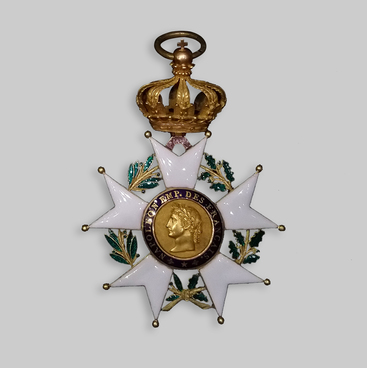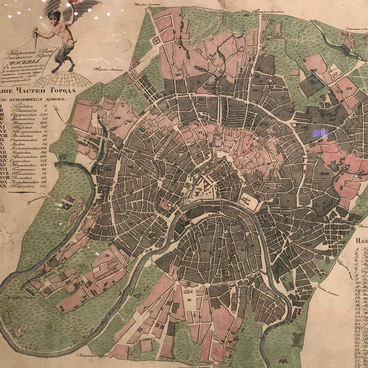Louis-Nicolas d’Avout (1770-1823), who earned the nickname Iron Marshal, is an outstanding commander, the only military leader of Napoleon’s troops, who did not lose a single battle. A loyal comrade-in-arms, he stuck with the disgraced Emperor in the most arduous period. The marshal took part in the Egyptian expedition and many prominent battles.
The year 1812 saw him in the battles of Smolensk and Borodino with the latter resulting in his concussion. Having returned from exile, Napoleon did not want to risk his loyal fellow, appointed him his minister, bestowed with the command of the capital troops. The Emperor persuaded Louis-Nicolas, ‘Paris I can entrust only to you.’ Being flattered a lot, the commander, desperately waving his protests and trying to escape to the front, could not help resigning to his fate.
The marshal’s baton, a symbol of valor, glories of the military and warriors, is the ultimate dream of every soldier. It makes thousands of people mount an endeavor towards victory. The story behind the baton, owned by d’Avout, is one very much known. Nikolay Karnovich, a warrant officer with the Life Guards Finnish Regiment, found it among other spoils of war captured on November 5, 1812 in the Battle of Krasny.
His battalion CO, Staff Captain Baykov, delivered the baton to St. Petersburg and presented it to the Emperor. Alexander I took off his St. George’s Order and awarded it to the officer. The Russians held a special grudge against the marshal, who had had his bedroom at the altar of the Cathedral Church of the Chudov Monastery during the occupation of Moscow. Imagine, right where a deacon used to pray for “peace of the whole world”, an armed adversary now reined. The insult could not have escaped the attention of the marshal.
St. Petersburg’s Vedomosti relayed this noteworthy event to people. November 13 saw ‘captured from the foe five banners and Marshal d’Avout’s imperious baton’ (as was registered in the Kammerfurier Ceremonial Journal) put on display during a ceremonial service, held in Kazansky Cathedral.
At the Imperial behest the relict was left in the Cathedral, where speaking Prince Kutuzov’s words “the victory adorns the shrine, and the shrine magnifies victory.” In the early 20th century, in preparation for the anniversary of the victory the trophies stored in the Cathedral, banners, keys to fortresses and d’Avout’s baton, were “permanently” transferred to Moscow’s Museum of the Patriotic War of 1812.
The baton became part of the exhibition arranged by the museum at the State Historical Museum to commemorate the centenary of the Victory over Napoleon and later was handed over to the Military Historical Museum. The baton, turned over to the State Historical Museum for a spell following the shutdown of the Military Historical Museum, ended up in the Museum of the Patriotic War of 1812 in September 2012, where it has been stored ever since.
The State Hermitage insisted over years that the baton, captured in the Battle of Krasnoye in 1812, had been kept here and would not concede till 2012 that the Museum of the Patriotic War of 1812 had the original baton in its collection. Recently another fact emerged stating that French historians believe that d’Avout’s only lost baton, awarded by Napoleon, is kept in the State Historical Museum.
The year 1812 saw him in the battles of Smolensk and Borodino with the latter resulting in his concussion. Having returned from exile, Napoleon did not want to risk his loyal fellow, appointed him his minister, bestowed with the command of the capital troops. The Emperor persuaded Louis-Nicolas, ‘Paris I can entrust only to you.’ Being flattered a lot, the commander, desperately waving his protests and trying to escape to the front, could not help resigning to his fate.
The marshal’s baton, a symbol of valor, glories of the military and warriors, is the ultimate dream of every soldier. It makes thousands of people mount an endeavor towards victory. The story behind the baton, owned by d’Avout, is one very much known. Nikolay Karnovich, a warrant officer with the Life Guards Finnish Regiment, found it among other spoils of war captured on November 5, 1812 in the Battle of Krasny.
His battalion CO, Staff Captain Baykov, delivered the baton to St. Petersburg and presented it to the Emperor. Alexander I took off his St. George’s Order and awarded it to the officer. The Russians held a special grudge against the marshal, who had had his bedroom at the altar of the Cathedral Church of the Chudov Monastery during the occupation of Moscow. Imagine, right where a deacon used to pray for “peace of the whole world”, an armed adversary now reined. The insult could not have escaped the attention of the marshal.
St. Petersburg’s Vedomosti relayed this noteworthy event to people. November 13 saw ‘captured from the foe five banners and Marshal d’Avout’s imperious baton’ (as was registered in the Kammerfurier Ceremonial Journal) put on display during a ceremonial service, held in Kazansky Cathedral.
At the Imperial behest the relict was left in the Cathedral, where speaking Prince Kutuzov’s words “the victory adorns the shrine, and the shrine magnifies victory.” In the early 20th century, in preparation for the anniversary of the victory the trophies stored in the Cathedral, banners, keys to fortresses and d’Avout’s baton, were “permanently” transferred to Moscow’s Museum of the Patriotic War of 1812.
The baton became part of the exhibition arranged by the museum at the State Historical Museum to commemorate the centenary of the Victory over Napoleon and later was handed over to the Military Historical Museum. The baton, turned over to the State Historical Museum for a spell following the shutdown of the Military Historical Museum, ended up in the Museum of the Patriotic War of 1812 in September 2012, where it has been stored ever since.
The State Hermitage insisted over years that the baton, captured in the Battle of Krasnoye in 1812, had been kept here and would not concede till 2012 that the Museum of the Patriotic War of 1812 had the original baton in its collection. Recently another fact emerged stating that French historians believe that d’Avout’s only lost baton, awarded by Napoleon, is kept in the State Historical Museum.



